The Intel Ivy Bridge (Core i7 3770K) Review
by Anand Lal Shimpi & Ryan Smith on April 23, 2012 12:03 PM EST- Posted in
- CPUs
- Intel
- Ivy Bridge
Discrete GPU Gaming Performance
Gaming performance with a discrete GPU does improve in line with the rest of what we've seen thus far from Ivy Bridge. It's definitely a step ahead of Sandy Bridge, but not enough to warrant an upgrade in most cases. If you haven't already made the jump to Sandy Bridge however, the upgrade will do you well.
Dragon Age Origins
DAO has been a staple of our CPU gaming benchmarks for some time now. The third/first person RPG is well threaded and is influenced both by CPU and GPU performance. Our benchmark is a FRAPS runthrough of our character through a castle.
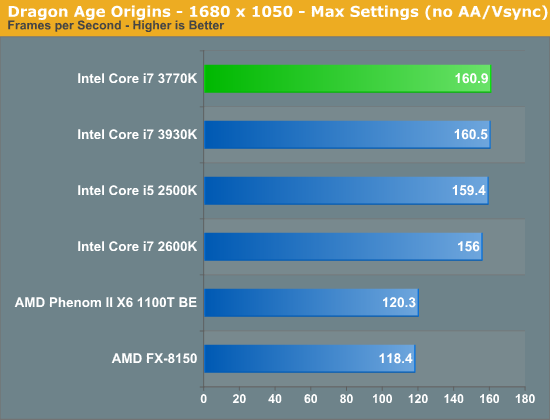
Dawn of War II
Dawn of War II is an RTS title that ships with a built in performance test. I ran at Ultra quality settings at 1680 x 1050:
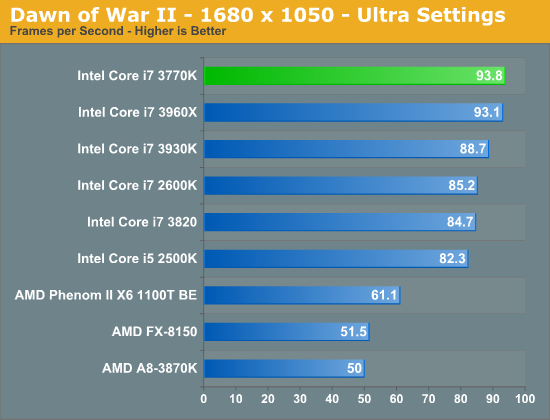
World of Warcraft
Our WoW test is run at High quality settings on a lightly populated server in an area where no other players are present to produce repeatable results. We ran at 1680 x 1050.
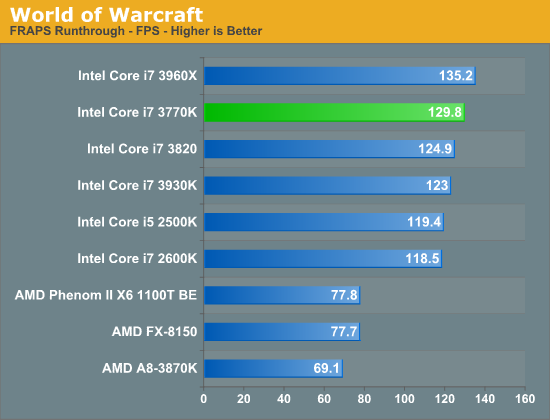
Starcraft 2
We have two Starcraft II benchmarks: a GPU and a CPU test. The GPU test is mostly a navigate-around-the-map test, as scrolling and panning around tends to be the most GPU bound in the game. Our CPU test involves a massive battle of 6 armies in the center of the map, stressing the CPU more than the GPU. At these low quality settings however, both benchmarks are influenced by CPU and GPU. We'll get to the GPU test shortly, but our CPU test results are below. The benchmark runs at 1024 x 768 at Medium Quality settings with all CPU influenced features set to Ultra.
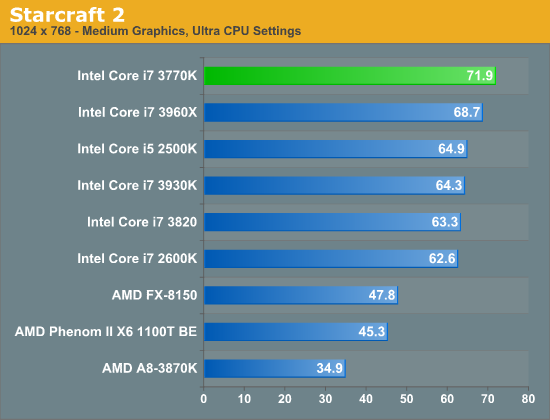
Metro 2033
We're using the Metro 2033 benchmark that ships with the game. We run the benchmark at 1024 x 768 for a more CPU bound test as well as 1920 x 1200 to show what happens in a more GPU bound scenario.

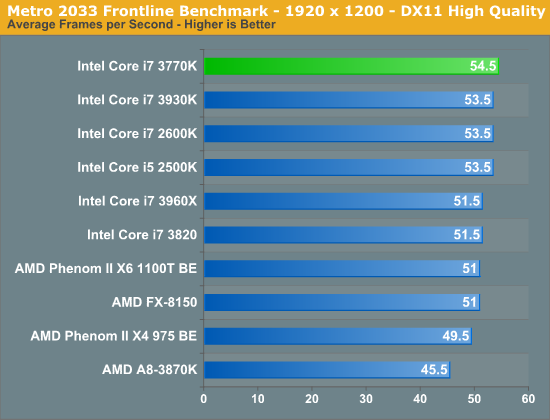
DiRT 3
We ran two DiRT 3 benchmarks to get an idea for CPU bound and GPU bound performance. First the CPU bound settings:
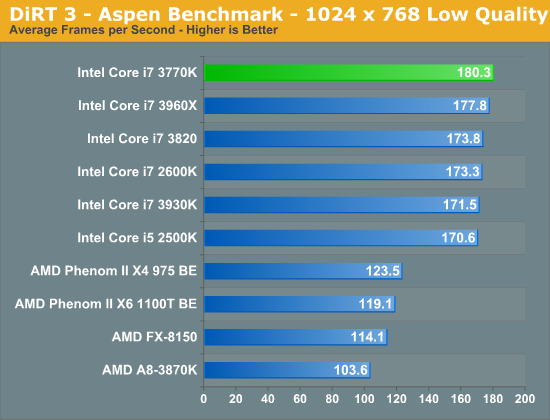
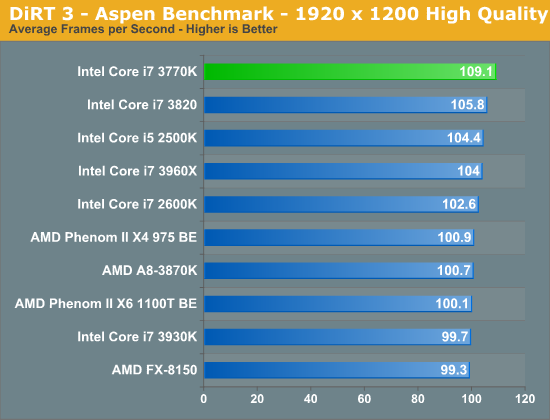
Crysis: Warhead
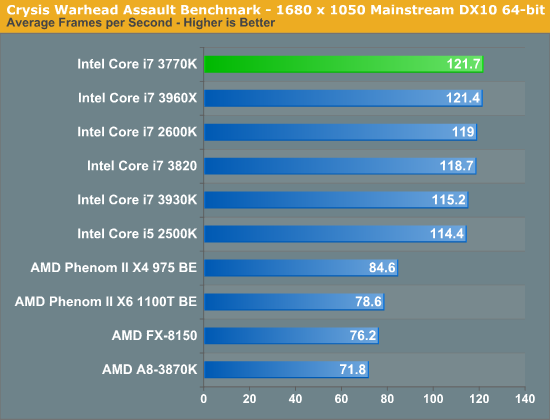
Civilization V
Civ V's lateGameView benchmark presents us with two separate scores: average frame rate for the entire test as well as a no-render score that only looks at CPU performance. We're looking at the no-render score here to isolate CPU performance alone:
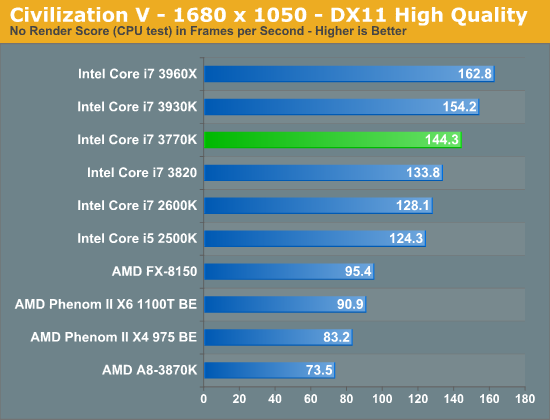










173 Comments
View All Comments
hechacker1 - Monday, April 23, 2012 - link
VT-d is interesting if you run ESXi or a Linux based hyper visor, as they allow to utilize VT-d to directly assign hardware to the virtual machines. I think you can even share hardware with it.In Linux for example you could host Windows and assign it a real GPU and get full performance from it.
A while ago I built a machine with that idea in mind, but the software bits weren't in place just yet.
I too with for an overclockable VT-d part.
terragb - Monday, April 23, 2012 - link
Just to add to this, all the processors do support VT-x which is the potentially performance enhancing spec for virtualization.JimmiG - Monday, April 23, 2012 - link
Really annoying how Intel decides seemingly at random which parts get VT-d and which don't.Why do you get it with the $174 i5 3450, but not with the "one CPU to rule them all", everything-but-the-kitchen-sink, $313 i7 3770K?
It's also a stupid way to segment your product line, since 99% of the people buying systems with these CPUs won't even know what it does.
This means AMD also gets some of my money when I upgrade - I'll just build a cheap Bulldozer system for my virtualization needs. I can't really use my Phenom II X4 for that after upgrading - it uses too much power and it's dependent on DDR-2 RAM, which is hard to find and expensive.
dcollins - Monday, April 23, 2012 - link
VT-d is required to support Intel's Trusted Execution Platform, which is used by many OEMs to provide business management tools. That's why the low end CPUs have support and the enthusiast SKUs do not. VT-d provides no benefit to Desktop users right now because desktop virtualization packages do not support it.I agree that it is frustrating having to sacrifice future-proofing for overclocking, but Intel's logic kind of makes sense. Remember, any features that can be disabled will increase yields which means lower prices (or higher margins).
JimmiG - Tuesday, April 24, 2012 - link
VirtualBox, which is one of the most popular desktop virtualization packages, does support VT-d. In fact it's required for 64-bit guests and guests with more than one CPU being virtualized.Does VT-d really use so many transistors that disabling it increases yields? AMD keep their hardware virtualization features enabled even in their lowest-end CPUs (even those where entire cores have been disabled to increase yields)
dgingeri - Monday, April 23, 2012 - link
"I took the last Harry Potter Blu-ray, stripped it of its DRM and used Media Espresso to make it playable on an iPad 2 (1024 x 768 preset)."I wouldn't admit that in print, if I were you. The DMCA goblins will come and get you.
p05esto - Monday, April 23, 2012 - link
They can say they're just kidding and used it as an example, because they would "never" actually do that. I think pirate cops would need more than talk to go to court. Imagine how bad this site would rip into them if they said anything, lol.XJDHDR - Monday, April 23, 2012 - link
Why? No-one loses money from transcode benchmarks. Besides, piracy is the real problem. If it didn't exist, there would be no DRM to strip away.dgingeri - Monday, April 23, 2012 - link
Sure, nobody loses any money, but the entertainment industry pushed DMCA through, and they will use it if they think they could get any profit out of it. It's one law, out of many, that isn't there to protect anyone. It's there so the MPAA and RIAA can screw people over.copyrightforreal - Monday, April 23, 2012 - link
Don't pretend you know shit about copyright law when you don't.Ripping a DVD you own is NOT illegal under the DMCA or Copyright act.
Wikipedia article that even you will be able to comprehend:
http://en.wikipedia.org/wiki/Ripping#Circumvention...